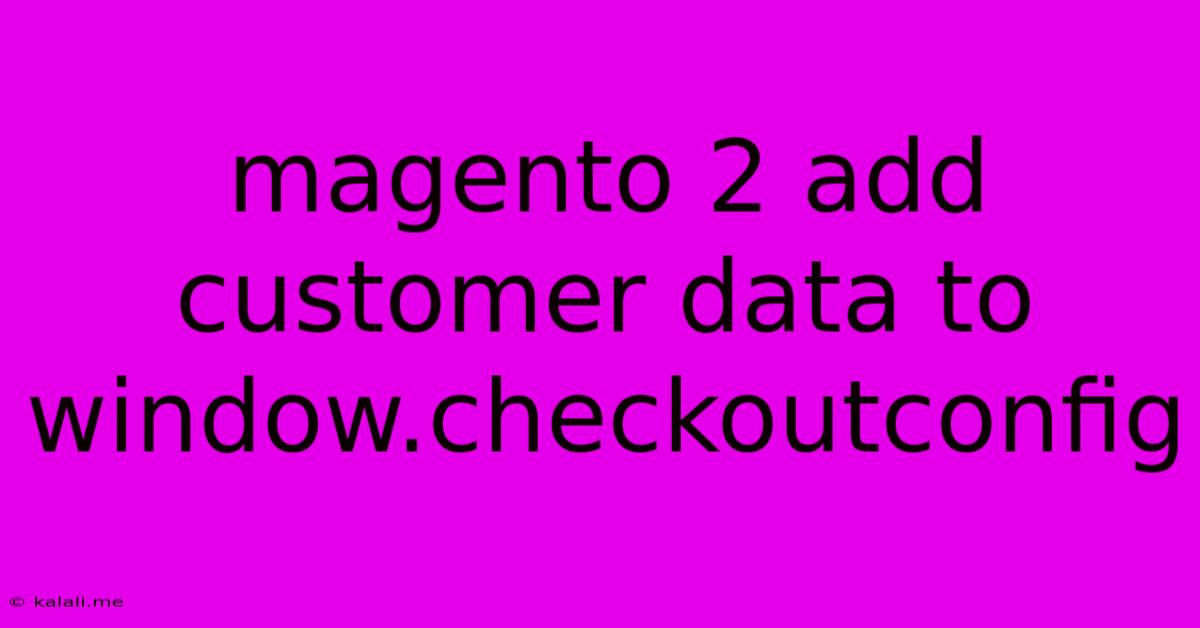Magento 2 Add Customer Data To Window.checkoutconfig
Kalali
May 23, 2025 · 3 min read

Table of Contents
Adding Customer Data to window.checkoutConfig in Magento 2
This article will guide you through the process of adding custom customer data to window.checkoutConfig in Magento 2. This is a common requirement for developers who need to access specific customer attributes or information within the storefront's JavaScript environment, often for customizing checkout processes or displaying personalized content. Understanding how to achieve this correctly ensures a smooth and tailored customer experience. We'll cover the steps involved, best practices, and potential pitfalls.
Why Access window.checkoutConfig?
Magento 2's checkout process heavily relies on JavaScript. The window.checkoutConfig object acts as a central hub, providing various pieces of information – payment methods, shipping options, and other crucial data – to the frontend. By injecting custom data into this object, you can seamlessly integrate your custom functionalities with the existing checkout flow.
Methods for Adding Custom Customer Data
There are several approaches to add customer data to window.checkoutConfig. The best method depends on your specific needs and the complexity of the data you want to add.
1. Using a Plugin:
This is generally the preferred and most robust method. Plugins allow you to intercept and modify the existing Magento 2 functionality without directly altering core files.
Steps:
- Create a plugin: Create a plugin that observes the
checkoutConfig'sset()method. - Intercept and extend: Inside the plugin's
aroundfunction, intercept theset()call. Access the existingcheckoutConfigdata and add your custom customer data. - Merge data: Ensure your custom data is properly merged with the existing configuration to avoid overwriting crucial data. Use the
_.extend()method (Lodash) for safe merging. - Register the plugin: Register your plugin in your module's
etc/di.xmlfile.
Example (Illustrative):
get(\Magento\Customer\Model\Session::class);
if ($customerSession->isLoggedIn()) {
$customer = $customerSession->getCustomer();
$config['customerData'] = [
'customAttribute1' => $customer->getCustomAttribute1(),
'customAttribute2' => $customer->getCustomAttribute2(),
];
}
return $config;
}
}
Remember to replace customAttribute1 and customAttribute2 with your actual customer attribute codes.
2. Extending the Config Provider:
This involves creating a new config provider that extends the core Magento\Checkout\Model\ConfigProvider. This approach requires more caution as it directly impacts the core functionality. It's generally recommended to use plugins for better maintainability.
Best Practices and Considerations:
- Security: Avoid exposing sensitive customer data unnecessarily. Only include data absolutely necessary for your frontend functionality.
- Performance: Keep the data you add lightweight to minimize the impact on page load times.
- Error Handling: Implement proper error handling to gracefully manage situations where data might be missing or unavailable.
- Testing: Thoroughly test your implementation to ensure it works correctly across different scenarios.
By following these steps and best practices, you can effectively add custom customer data to window.checkoutConfig in Magento 2, enhancing the checkout experience and enabling personalized features for your customers. Remember to always prioritize security and performance while implementing this. Using plugins remains the safest and most maintainable approach.
Latest Posts
Latest Posts
-
25 Cents A Minute For An Hour
Jun 30, 2025
-
In Music What Does Allegro Mean Math Answer Key Pdf
Jun 30, 2025
-
What Is 1 5 Of A Tablespoon
Jun 30, 2025
-
How Long Does It Take To Drive Through Illinois
Jun 30, 2025
-
If I Was Born In 1988 How Old Am I
Jun 30, 2025
Related Post
Thank you for visiting our website which covers about Magento 2 Add Customer Data To Window.checkoutconfig . We hope the information provided has been useful to you. Feel free to contact us if you have any questions or need further assistance. See you next time and don't miss to bookmark.